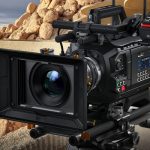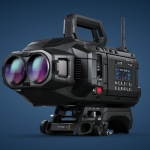'Kyaddala''s intense storyline instantly won the hearts of millions of viewers in Africa for its powerful portrayal of young adult issues on the continent. We bring you a behind-the-scenes look at how the production and editing of season two helped craft a cinematic yet vibrant look designed for its youthful audience.
Kyaddala was an instant hit among African audiences, especially in East Africa, when it was broadcast nationwide. Both seasons of the drama, which focuses on real-life social issues, were shot on the Blackmagic URSA Mini Pro 4.6K, with the second season also benefiting from a camera to post workflow including edit, colour and finishing in DaVinci Resolve Studio. The series was produced by Emmanuel Ikubese Films together with the NGO Reach a Hand Uganda. Ugandan screenwriter Usama Mukwaya produced all episodes and directed the second season, which has just finished airing.
Kyaddala, a Luganda word meaning ‘it’s real’, examines issues of sexually reproductive health through the lens of school-age characters and their parents, teachers and mentors. While season one was set in a secondary school, season two follows some of the same characters as they enter university. One storyline concerns a student who marries an older man after leaving school, and how they both fare when she goes back to college to further her education.
 Critics have heralded the series as changing the face of television in Uganda.
Critics have heralded the series as changing the face of television in Uganda.
“The drama is a way to address the challenges faced in our community about HIV, teenage pregnancy and gender-based violence, which significantly increased at home during Covid,” explains Sserwadda Shafic, who supervised postproduction across both series and worked closely with Usama as cinematographer and colour grader on season two. “By using fictionalised situations based on real-life issues, the aim is to help young people and their parents make more informed decisions.”
Season one was shot on the URSA Mini Pro 4.6K using ProRes 422, with Kyaddala’s producers upgrading to the 4.6K G2 for the second run.
“We loved working with the URSA Mini 4.6K and chose the G2 camera for its ability to shoot Blackmagic RAW, its inbuilt ND filters and the colour science,” says Shafic. “We chose the DZO film Pictor zoom lenses for its clinical film look with their beautiful bokeh and soft rolloffs. We shot with the 20-55mm and 50-125mm T2.9 lenses at an aspect ratio of 16:9.”

To reflect a storyline centred on the sexual reproductive health rights of young people, the filmmakers built a palette based on youthful colours to achieve a cinematic but vibrant look. The show was largely shot on location at Hana International Mixed School in Kampala and lit by ARRI Skypanels and fresnels tuned to illuminate rich natural skin tones.
“Our approach was to achieve a natural warm feel that could help the audience relate with the different events happening in the series,” says Shafic. “The script was quite intense in terms of story, locations and the number of cast we were working with.”
Shafic, who owns local postproduction facility Incredible Media, set up a QNAP NAS server as the show’s main storage source into which he networked the show’s six editors.

“We used the DaVinci server to achieve a collaborative workflow where all editors could edit simultaneously in the same project. This was a massive step up from the first season, where we were using another editing software which we found just couldn’t handle the amount of data we needed it to. We were waiting hours for content to upload. As soon as season two was commissioned, I researched online, found some tutorials about DaVinci Resolve and knew way ahead of time that this is what we’d use.”
Media from the production totalled over 50TB, all at 4K RAW. With DaVinci Resolve, post-production was cut by half, from six months to three.
Shafic continues: “We can have one or more people editing on the fly, another mixing sound and music, another doing graphics, while I’ll be applying a grade across the whole series – and it was mind-blowing. I feel like it is the best thing that has happened to us. We are so much faster now and able to be so much more creative as a team.”
 He himself has a background in IT, and just a couple of years ago was more familiar with servers in banks than in film and TV. His passion for filmmaking led him to change careers.
He himself has a background in IT, and just a couple of years ago was more familiar with servers in banks than in film and TV. His passion for filmmaking led him to change careers.
“I am a self-taught filmmaker learning every day. I didn’t discover LUTs until I read how Roger Deakins crafted the look of 1917 by embedding an LUT into the camera. That is something I will investigate going forward.”
His professional IT experience did prove an advantage in figuring out how to manage media. “I set up a file structure and explained it to all our editors, our sound recorders and DIT. It was a simple folder structure breaking down the footage by scene, scene number and take. We all had the same information.”
 Kyaddala season two has generated a remarkable response across the region. Picked up by broadcasters in Kenya and Tanzania, the show is striking a chord in its ability to teach young adults and those who work with and care for them how to handle some of society’s most pressing issues.
Kyaddala season two has generated a remarkable response across the region. Picked up by broadcasters in Kenya and Tanzania, the show is striking a chord in its ability to teach young adults and those who work with and care for them how to handle some of society’s most pressing issues.
“The impact of the show has generated a massive movement when it comes to talking about the issues surrounding teenage pregnancy and gender-based violence. More than anything technical, that is where the major success is.”
As a result, Kyaddala season three is currently being written, with Shafic already planning to shoot this on the URSA Mini Pro 12K and use a DaVinci Resolve post workflow.
















































































